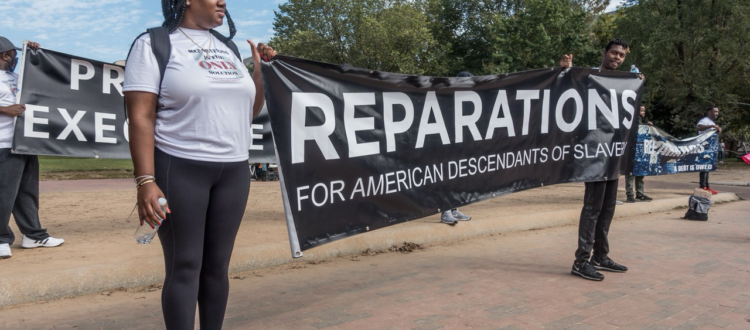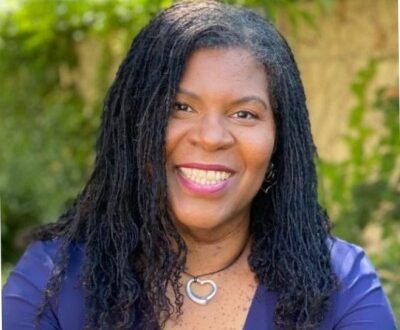Bo Tefu and Antonio Ray Harvey | California Black Media
The Weingart Foundation Names Crystal Crawford Senior Director of Strategic Partnerships
The Weingart Foundation, a private, non-profit grantmaking organization focused on racial justice, has named Crystal Crawford its inaugural Director of Strategic Partnerships.
In the role, Crawford will oversee strategic partnerships and manage relationships with various stakeholders.
“Crystal Crawford is an experienced and strategic leader who has demonstrated a deep commitment to advancing justice and equity for vulnerable communities across California,” said Joanna S. Jackson, interim President and C.E.O. of the Weingart Foundation.
“As a nationally recognized leader in fighting poverty and advancing health and well-being, particularly in communities of color, she will be a tremendous addition to the Weingart team. We look forward to working with Crystal to cultivate meaningful partnerships that will help us strengthen our work serving communities most impacted by systemic inequities,” Jackson added.
Currently, Crawford serves as Executive Director of the Western Center on Law & Poverty, a legal and advocacy organization focused on bringing systemic and structural change to government.
Previously, Crawford was a program director at The California Wellness Foundation. At the Wellness Foundation, she developed several initiatives, including a groundbreaking multi-million-dollar investment that advanced the health and economic security of women of color.
Before joining Cal Wellness, she served as C.E.O. of the California Black Women’s Health Project.
“I have been a long-time admirer of the Weingart Foundation’s outstanding commitment to racial justice and racial equity. Its impactful work has helped to transform communities and systems,” Crawford said.
“At this time when work advancing racial justice and diversity, equity and inclusion is under heightened attack, I am looking forward to working with my colleagues as we deepen the foundation’s work in communities and forge new partnerships with courage and boldness,” she added.
Activist and Organizer Peggy Moore and Wife Die in Fatal Car Crash
Family members, friends, colleagues, and business associates across California are mourning the tragic loss of Peggy Moore, 60, and her wife Hope Wood, 48. The couple passed away in a car accident that occurred on May 10 in San Diego County.
According to multiple reports, the fatal collision on State Route 76 claimed the lives of four people, with another person sustaining serve injuries.
In 2019, Moore and Wood founded Hope Action Change, an organizational development consultancy and coaching firm. They both had experience working as organizers, strategists, and leaders in education, electoral and issue-based campaigns, and public affairs.
The couple first met while working on Barack Obama’s presidential campaign in 2008.
The news of their passing has elicited a wave of condolences from numerous business and political leaders and Black-led organizations across the state.
“I met Peggy back in 2004. She’s been an amazing sister friend of mine,” said LaNiece Jones, a member of Black Women Organized for Political Action (BWOPA).
“This morning, my heart broke with the news of the sudden death of Peggy and her dear wife, Hope. My sincere condolences to the family and friends of Peggy and Hope. I am still in shock. Both Peggy and Hope are brilliant and caring individuals who deeply loved giving to the community and the community deeply loved them back.”
Rep. Barbara Lee (D-CA-12) took to social media platform X to share her grief.
“I’m heartbroken to hear of the tragic loss of Peggy Moore and Hope Wood. Peggy was a friend, an activist, and one of the best organizers I knew. Her passion and fight for justice and equality is what brought her and Hope together,” wrote Lee.
Gov. Newsom Announces Cuts to Address Budget Deficit
On May 10, when Gov. Newsom presented his revised state budget, he announced a number of cuts to address the state’s estimated $44.9 billion budget deficit over the next two years.
In the spending plan, Newsom unveiled a plan to shrink the state budget by $32 billion in planned spending by eliminating 10,000 vacant state jobs, pausing an expansion of subsidized childcare and cutting billions in funding for climate change programs.
“Even when revenues were booming, we were preparing for possible downturns by investing in reserves and paying down debts – that’s put us in a position to close budget gaps while protecting core services that Californians depend on,” Gov. Newsom said.
“Without raising taxes on Californians, we’re delivering a balanced budget over two years that continues the progress we’ve fought so hard to achieve, from getting folks off the streets to addressing the climate crisis to keeping our communities safe,” he added.
In the revised budget, Gov. Newsom proposed reducing government spending on operations by 8% and removing 10,000 vacant government positions. The cuts will allow the Newsom administration to avoid increasing taxes or implementing state worker furloughs.
Newsom said he and legislators also agreed in April to borrow $4.2 billion from the state’s “rainy day fund.”
Newsom said local governments will continue to invest in specific programs mainly housing, healthcare, and education. Gov. Newsom will cut $300 million for state and local public health programs and an additional $820 million for healthcare workforce development.
Public Health officials criticized Newsom’s proposal.
“Local public health officials are astounded that just one year after the COVID-19 public health emergency ended, the administration has proposed repeating the same mistakes that left public health departments under-prepared and under-resourced and communities of color so vulnerable,” said Michelle Gibbons, Executive Director of the County Health Executives Association of California said in a statement.
Cal. Supreme Court Could Strip Gov and Legislature of Power to Raise Taxes
On May 8, the California Supreme Court heard oral arguments on the Taxpayer Protection and Government Accountability Act, a measure that has already been approved for the November ballot. It calls for restricting the state Legislature and Governor’s ability to increase taxes without statewide voter approval.
California business owners back the measure while Labor unions have rallied in opposition to it.
Gov. Gavin Newsom and legislative Democrats have petitioned the Supreme Court to remove the proposal from the ballot since the California Constitution requires a constitutional convention to ratify the ballot with a two-thirds majority vote in the legislature.
Democrats and labor unions stated that the ballot measure could limit state and local funding thus crippling the state’s ability to produce new sources of revenue. A reduction in revenue may result in government programs and initiatives being underfunded,” they say.
Legislative Democrats also argued that the measure’s economic impact will make it harder to resolve the state’s budget deficit.
Business owners and company leaders advocating for the ballot measure stated that the tax initiative can help form new checks and balances on taxation and attract companies to invest in California creating more jobs.
President of the California Business Roundtable Rob Lapsley, a supporter of the tax initiative, said that people are fed up with the state’s high taxes.
“This gives the people of California the right to vote on future taxes, and voters are going to support it if it’s on the ballot,” Lapsley said.
Opposers of the tax initiative, mainly labor unions and state workers such as teachers, police officers, and firefighters, have aligned with Legislative Democrats to reject the tax law.
Executive director of Service Employees International Union California Tia Orr said the tax law was created to benefit wealthy corporations and deceive the average taxpayer.
“I want to make it clear that the ‘Taxpayer Deception Act’ let’s wealthy corporations, who can afford expensive campaigns, to block taxes on their industries while regular Californians, regular people, shoulder more of the cost of critical services,” Orr said.
The California Supreme Court is expected to make a ruling on the future of the initiative by June 27 this year.
State Assembly: Tensions Flare at Budget Committee Hearing on State Homelessness Spending
California lawmakers expressed frustration with Gov. Gavin Newsom’s administration, pointing to its inability to produce reliable data on state funding allotted to homelessness and housing initiatives.
State officials questioned the Newsom administration about the billions of dollars spent to address homelessness and the growing housing crisis in California during a tense legislative hearing on May 6.
The Assembly’s Budget Subcommittee on Oversight and Accountability held a two-hour-long hearing raising questions and concerns about the state’s Homelessness Housing and Assistance (HHAP) grant program. Gov. Newsom’s administration allocated $24 billion in the last five years to address homelessness and the housing shortage, according to the Legislative Analyst’s Office. A report by the state auditor revealed that the governor had invested state funds in nine agencies and over 30 programs aimed at reducing homelessness.
Federal data also showed that homeless homelessness in California increased by 6%.
Assemblymember Phil Ting (D-San Francisco) pressured the governor’s administration to produce data that showed the impact of state housing programs. However, the administrators failed to present results stating that the data was unavailable.
“You come to a budget committee, and there are no numbers,” Ting said during the hearing. “You’re coming to the hearing today, we’ve spent billions, and you can’t tell us at all how many people we’ve helped?”
Leaders of agencies that received state funding said the system is undergoing transformation and working on methods to monitor and evaluate existing programs that address homelessness and provide housing.
Deputy Director for the California Department of Housing and Community Development Megan Kirkeby said that the state did not require cities and counties to show how funds were spent on housing programs.
Republican opposition stated that the lack of data and accountability discredited Democrats and loosened their power grip in Sacramento as a result of the one-party rule.
Assemblymember Josh Hoover (R-Folsom) was among the committee members officials who called for a state audit that revealed the pressing issue.
“The long and short of it is we have to stop measuring success by how many dollars we’re spending,” Hoover said.
“I am frustrated by the lack of urgency that I see today and the lack of data,” he said.
Although Democrats and Republicans raised reasonable concerns regarding the lack of transparency, city officials still requested more funding to address homelessness. Los Angeles Mayor Karen Bass, San Diego Mayor Todd Gloria, and Sacramento Mayor Darrell Steinberg urged the state to increase program funding by an additional $1 billion.
Expect to See a New Flat Rate Fee of $24 on Your Electricity Bill
Last week, members of the California Public Utilities Commission voted to approve adding a $24.15 flat fee to monthly utility bills starting next year.
On May 9, the California regulators took the unanimous vote in favor of the proposal which also reduced the cost of utilities per kilowatt hour but added the fixed charge to mitigate the loss. The new charge will be based on income with lower-income households paying between $6 to $12. Middle-class to high-income households will be expected to pay the full amount.
CPUC President Alice Reynolds and environmental groups argue that the new rate encourages people to use more clean energy and assist in modernizing the grid.
“We’re marching towards the future we want to see; we want this load growth,” Reynolds said.
“One where we can replace gas-guzzling cars on our roads with EVs that run on clean electricity and emit less pollutants,” she added.
Although the fixed charge is supposed to lower the utility bill for residents, opponents of the charge argue that a flat rate increases the monthly bill for middle and high-income households.
California currently operates under a prepaid model and maintenance of the power grid is included in the overall usage rate. But with this new proposal, residents will pay more than double the national average of $11 for electricity.
Cynthia Martinez, a spokesperson for the Predictable Power Coalition, an advocacy group, argued that a flat rate is more equitable and will reduce the cost of utilities for struggling families.
“For people who live in hotter climates, who really have no choice but to run their air conditioning more often, they’re paying higher costs that go toward grid upkeep,” Martinez said.
In the past, Democrats stalled plans at the state Capitol to approve the flat fee. All 14 Democrats in the Senate Energy, Utilities, and Communications Committee abstained from voting during a hearing on the proposal to roll back the flat rate.
California Approves $1.3 Billion to Restructure Community Schools
The State Board of Education and Governor Gavin Newsom announced last week that they have approved $1.3 billion in grants to implement a new school initiative that offers students support outside the classroom.
According to a press release dated May 8, State education officials have appropriated funds since 2021 to offer students and their families resources such as health care, mental health support, and social services. The State’s board awarded $1.3 billion to 288 local education agencies that fund and support 995 schools statewide.
The California Department of Education plans to mobilize resources to help students thrive in school and at home. This initiative includes summer programs, tutoring, and counseling.
Gov. Newsom said that the state is expanding community schools across the state. Students will be offered free meals twice a day, mental health counseling, and after-school programs.
“California is transforming education to make schools a place where every family and student can succeed,” Newsom said.
The state is developing the initiative as part of the California Community Schools Partnership Program (CCSPP), a ten-year plan that promotes equity and quality education for students in California. The state will spend $4.1 billion with its partners including community schools, local counties, government agencies, and nonprofits that provide health, mental health, and social services.
State Board of Education President Linda Darling-Hammond is eager to uplift communities with well-resourced schools and achieve equity in public education.
“We know children learn best when they are healthy, happy, and in a learning environment where they are surrounded by knowledgeable and caring adults attuned to their needs,” Darling-Hammond said.
State Superintendent of Public Instruction Tony Thurmond endorsed current school programs and anticipates promising results as grants are invested in these programs.
“Our Community Schools continue to serve as exemplars of programs that educate the whole child. I am proud to see California continue to be at the forefront of recognizing that student wellness is a cornerstone of learning,” Thurmond said.
The California Department of Education will award a final round of grants to community-based organizations and schools during the 2024-2025 academic year.
California Makes Strides in Fight Against Fentanyl
California National Guard’s Counterdrug Task Force has seized over 7,000 pounds of fentanyl including 3.4 million pills since the state launched a multi-agency operation in January 2024.
Gov. Gavin Newsom announced the state’s progress on May 7, National Fentanyl Awareness Day.
The Governor said he deployed the state’s highway patrol and National Guard personnel last year as part of a public safety operation in partnership with local government officials and law enforcement.
“As we recognize the serious dangers of illegal fentanyl, California is continuing to tackle this issue head-on. Our efforts are getting this poison off our streets and out of our communities as we continue to support people struggling with substance use.” Newsom said.
CalGuard Major General Matthew Beevers said that the state’s unprecedented investment in the Counterdrug Task Force has immobilized operations and revenue channels of transnational criminal organizations.
“The CalGuard is committed to supporting our state, federal, local and tribal law enforcement partners to eliminate the scourge of fentanyl,” Beevers said.
In the past five years, California has invested $1.1 billion in operations and initiatives to fight crime, support local law enforcement, and improve public safety. The Newsom administration has implemented a comprehensive approach as part of the governor’s Master Plan to tackle the fentanyl and opioid crisis.
The Newsom administration has expanded efforts to improve public safety across the state where operations occurred in cities such as San Francisco, Oakland, and Bakersfield.
San Francisco Mayor London Breed acknowledged that joint operation was a step in the right direction toward curbing illegal activity and improving public safety.
“Our coordinated work to shut down drug markets in San Francisco is making a difference, but we have more work to do,” Breed said.
“Together we are sending a message at all levels of government that anyone selling fentanyl in this city will be arrested and prosecuted,” she said.
State Cuts Financial Aid and Shrinks Education Programs in Revised Budget Proposal
California financial aid programs for college students will shrink over the next two years, according to Gov. Gavin Newsom’s newly revised budget proposal presented last week by Governor Gavin Newsom.
The state is set to reduce funding for the Middle-Class Scholarship by an estimated $510 million. The scholarship program is one of the biggest in the state and cuts will affect over 300,000 students who rely on the program for financial aid. Middle-class students on this scholarship, receiving at least $2,500 annually to attend state universities.
Community college students were eligible for the Cal Grant, a program that awarded recipients with $1,600 to cover living costs. The grant program was initiated after the COVID-19 pandemic to help students with remote learning. Gov. Newsom promised to expand the program but has changed those plans to close the state’s estimated $27.6 billion budget gap over the next fiscal year.
Jake Brymer, deputy director of policy and public affairs at the California Student Aid Commission said students will receive a smaller scholarship award and could lose more than half of their financial aid in the fall.
David Ramirez, a University of California Los Angeles senior, received $7,500 from the Middle-Class Scholarship.
“I wouldn’t be able to attend this university if I didn’t have that financial aid,” Ramirez said.
Ramirez advocated for student financial aid and support as the government relations chair for the UC Student Association. Although he will graduate this year and start a public service fellowship, he has $10,000 in student loans.
“I’m supposed to be celebrating my graduation,” he said, “But I’m also worried about paying for rent,” he said.
State lawmakers still have room to negotiate with the Governor before the budget is finalized. Student advocates recommend that the state reduce the number of students awarded the scholarship rather than reduce the award amount.
The legislature has until June 15 to finalize and approve the governor’s budget.
Gov. Newsom Proposes Cuts to Spending on Homelessness and Housing
California Governor Gavin Newsom plans to spend less on solving the homeless crisis to help manage the state’s budget deficit,
“I know that may not sit well with some,” Newsom said.
“But we’re struggling with seeing the performance I want to see on the streets,” he said.
Gov. Newsom wants to cut bonuses worth $260 million meant to fund cities and counties over the next two years. Cities and counties were required to submit two state-approved plans that reduced homeless populations and produced housing for residents. However, the Governor has paused plans to pour more money into addressing homelessness and the housing crisis since cities and counties failed to track spending or produce credible data on the impact of housing programs statewide.
Last year, the state spent $1 billion on housing programs including the Homeless Housing, Assistance and Prevention program. However, city mayors argued that funds were inadequate, and programs were at risk of failing. Mayors from 13 of the state’s largest cities went to Sacramento last week to urge Gov. Newsom to provide a permanent source of funds for housing programs.
Sharon Rapport, director of California state policy for The Corporation for Supportive Housing said the results of the cuts the Governor is proposing could be dire.
“There’s some shelters that will close as a result of no additional funding in this year’s budget,” Rapport said.
Gov. Newsom also proposes cutting the Multifamily Housing Program and grant funding for local homelessness policy.
Nevada Merriman, vice president of policy at MidPen Housing, a nonprofit affordable housing developer said Newsom’s spending plan negatively affects programs that help low-income families.
“These are the funding sources that the most vulnerable Californians rely upon,” Merriman said.
Newsom said that the proposed budget cuts indicate that “these are tough days.” The governor is still working with the Legislature to fully resolve the state’s budget deficit before the June 15 deadline.











